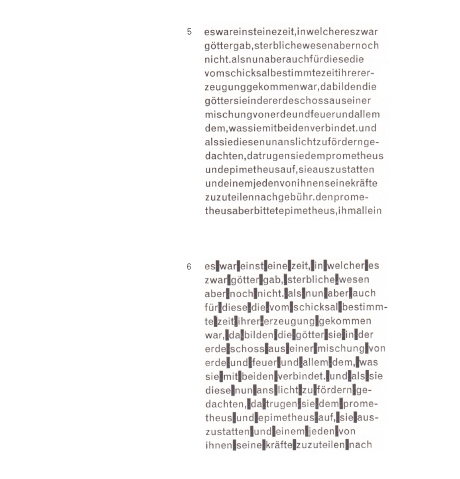 [/wide]
In the typography there are three possibilities for working with rhythmic values:
[/wide]
In the typography there are three possibilities for working with rhythmic values:
1 To accept rhythmic values
without the suggestion influence.
2 To accept rhythmic values with
a certain suggestion of influence.
3 Consciously designed rhythmic values.
Emil Ruder
rhythm
タイポグラフィにおけるリズム値(ヴァリュー)への
取り組み方には3つの可能性がある
1 意識されないリズム値
2 ある程度意識されたリズム値
3 意識的にデザインされたリズム値
エミール・ルーダー
リズム
1. Rhythmic values without the
suggestion of influence
Type is the basis of all typography but particularly so in the case of script. The flowing movement produced by writing can be compared to the lapping of waves produced by water. Effect and counter effect form both the water’s wave and that of script too. Type is a rhythmic shape with a succession of similar shapes. Its chief rhythmic elements are: straight – curved, vertical – horizontal, arch shaped – garlanded, slanted – backslanted, circular – straight, pressure – resistance, tension – counter tension, upwards – downwards, start – end.
A good typeface recognizes written script as its starting point. The procedure of type casting (original drawing, template, mould, cast letter) should not completely obliterate
the original written letter. It is right that a typeface is labelled degenerative when its original written form no longer plays a part. Every typeface, even the sanserif, must show the differences in stroke width which are achieved when using a broad-nibbed pen. The typeface may then also
be judged as a rhythmic image and used in the awareness and knowledge of these values.
意識されないリズム値
文字はあらゆるタイポグラフィの基礎だが、筆書の場合はとくに重要である。書くときの流れるような動きは、
水の波立ちに比べられる。波と同じように、作用と反作用が文字を形づくる。文字は似たような形の連なりによる、リズミカルな構築物なのだ。その最も主要なリズム的要素は次のようなものだ。直線 – カ-プ、垂直 – 水平、アーチ – 輪っか、傾斜 – 反傾斜、円形 – 直線、作用 – 反作用、緊張 – 対緊張、上方向 – 下方向、開始 – 終了。
優れた印刷活字は書き文字を出発点として尊重する。書き文字のニュアンスは活字の鋳造プロセス (製図、テンプレート、鋳型、鋳造) のなかで完全に消されるべきではない。手書きの効果が消えてしまった活字は、劣化したものとされても仕方がない。幅広いペンで書くことによる線幅の変化はあらゆる活字 – グロテスク体 (サンセリフ体) を含め – が明示せねばならないものだ。そうすれば、活字もまたリズム的形成物として価値づけられ、リズムへの意識のなかで用いられるだろう。
Every creative person is – in danger
of not heeding the values with which he is in daily contact. His feeling
for form becomes blunted; the daily contact with cultural things often ends in a complete disregard for cultural values. In view of the foregoing it seems there is a need for us to examine a normal piece of setting
through rhythmic values (1). We use a method whereby attention is drawn to the removal of a value which is known to be irreplaceable. We take out an important rhythmical element (upwards-downwards). The result is a piece of setting without ascenders and decenders (2), a piece which has lost its rhythmic flow and where the setting is disturbed. The lines have become uniform and the evenly matched characters are too sequential. The setting precludes any incen-tive to read. The same setting without circular-straight elements (3) yields a prickly, agitated image and it becomes clear why circular elements perform a soothing and balancing role in the rhythmic effect of type. (4)
But the same setting can also be
put in a different context to that of our theme. The spacing of words subdivides lines and setting into text of unequal length, that is to say, in a rich, rhythmic occurrence of values of varied width and different weight.
The abandonment of subdivision and rhythm — practised and so rarely valued by us day in and day out — is shown in the extent of the impoverishment (5). Long ribbons of line emerge, barely readable, tiring in quantity. The effect of unequal lengths is clearly shown when the word spacing is brought to the fore (6).
Helmut Schmid has wonderfully restructured the article in the idea 354 based on the article to be published in the April 1959 issue of “Typografische Monatsblatter” by Emil Ruder. So, we highly recommended that to be read the idea 354 thoroughly. And then you can get a deep understanding of this article.
全てのデザイナーは、彼が日々関わっている価値について注意を払わなくなるという危険と隣り合わせである。フォームへの感覚は鈍りやすい。つまり、芸術・文化に関する事物を相手にしていると、それらが持っている特殊な性質への感覚が失われやすいのだ。それゆえ、リズムの問題をごく一般的なテキストを通して探求することが必要であるように思われるく(1)。ここでは、代替不可能な重要な要素をひとつひとつ消去していき、その結果を観察するという方法をとってみよう。まず、重要なリズム要素 (上下方向)を取り去ってみる。こうして生まれたアセンダとディセンダのない版面 (2)は、リズムの流れが失われ、とても読みにくい。行は単調で、均質な文字が切れ目なく続き、読むための引っかかりがまるでない。同じテキストから丸みの要素を無くしてみると (3)、トゲトゲしい興奮したような版面が生じ、丸みというものが文字のリズムの戯れのなかでいかに安心感をもたらし、バランスをとるような役割を果たしているのかがよく分かる(4)。
この同じ版面を我々のテーマの別の角度から考えてみることもできる。つまり、さまざまな諸問と語長によって組まれた行に現れる、さまざまなヴァリューのリズムによる豊かな戯れだ。この区分けとリズム化、あまりにも当たり前すぎて、しばしば低く評価されている – を無くしてみれば、そこにはひどい貧しさが現れる (5)。 長々とした行の連なりは、ほとんど読むこともできず、その堆積は見るものをぐったりとさせる。語の間を可視化すれば(6)、さまざまな単語の長さによる戯れがはつきりと分かる。
このコンテンツはTypografische Monatsblatterの1959 4月号に掲載されたEmil Ruder氏の寄稿記事をHelmut Schmid氏が40年以上の歳月を要し、idea 354の中で編集、デザイン、紹介されたものを一部引用したものです。
次のことをお勧めします、もしあなたがidea 354を熟読すると、このコンテンツを表面的なレベルより深く理解することができます。
